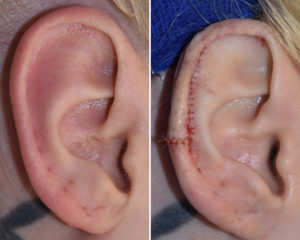Changing the shape of the ear is most commonly done by a traditional otoplasty or ‘ear pinning’. While the size of the ear may seem to get a bit smaller in otoplasty as it moves the ear closer to the side of the head, the actual ear size does not really change.
True ear size reduction involves a vertical change in the length of the ear from the superior helix down to the bottom of the earlobe. The most recognized ear reduction procedure is that of earlobe modification. The earlobe can be reduced by a variety of techniques but, regardless of which method is used, they all create some reduction in its vertical length as all large earlobes hang too low.
The most dramatic way to reduce a large ear is to cut out a portion off its middle, bringing the upper and lower thirds of the ear closer together. But the scar that is created by doing so would be aesthetically unacceptable and such ear reductions are only usually done in skin cancer resections.

While often combined with ear reduction for maximal ears height reduction as in macrotia reduction surgery, the scaphal flap reduction technique can be done alone if the earlobe is already small enough. Int its use it is important to remember that its effect is in reducing the size of the upper third of the ear.
Dr. Barry Eppley
Indianapolis, Indiana


